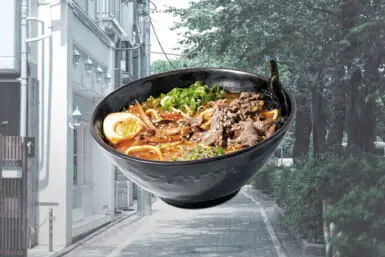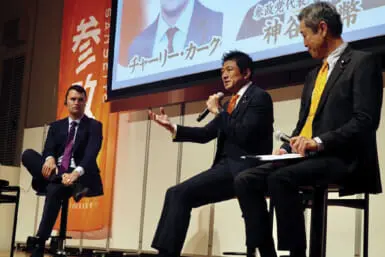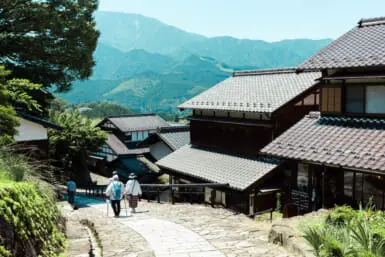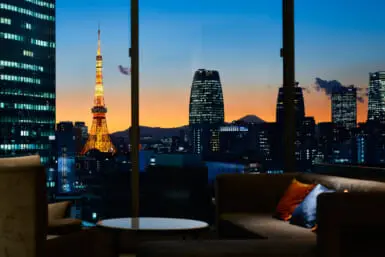I went up three times this last week to the successive grand openings of Roppongi Hills. First, on Monday, there was a press conference with developer Minoru Mori, and a press preview—a chance to see round one of the most outstanding property developments in the history of this country.
Next, on Tuesday, there was a big opening party for 4,000 of Mr. and Mrs. Mori’s closest friends—a jam-packed event, with literally thousands of people clogging up the elevators to get to the 51st floor of Mori Tower, where the party was.
Finally, on Wednesday, there was the ceremonial opening of the Grand Hyatt Tokyo Hotel, a central feature of the new Roppongi Hills complex. Again, there were guests coming out of the walls.
It makes you wonder. Japan is on its last legs, the nation’s economy is going to carry on deflating, until we all drop. Or that is what we are reliably told. Yet here is this monster development opening up in Roppongi—of all places—and you can see people streaming up and down Roppongi Dori at night, watching the searchlights play on the face of the Mori Tower, with their mouths open.
It is a big tower, the largest office building in Japan. As an extension of one man’s persona, it is sizable. So how does Mr. Mori, 67, feel about it?
I have been tracking his projects—he has a bold scheme for Shanghai as well—for 6-7 years now. From the very beginning, in articles I wrote for Tokyo Weekender, I have been comparing Roppongi Hills, as a development, to Rockefeller Center in Manhattan. In other words, it is deliberately positioned—like Rocky Center in the 1930s—to serve as a call to arms in harsh times. The idea is to give people a boost, to lift society a bit, to suggest that there is no reason to simply give up.
Mr. Mori, however, is no longer impressed by the comparison. “Put simply, the scale of Roppongi Hills is twice that of Rockefeller Center,” he says.
Roppongi Hills has a plethora of features, he also points out, perfectly correctly, that you don’t find at Rocky Center.
There is a contemporary art museum, a five-star hotel owned by Mori Building, a TV complex and headquarters—TV Asahi, a pond, and Japan’s largest movie house managed by Virgin and owned by Toho. To make the whole area green, the developer planted some 68,000 shrubs, bushes, plants and trees.
The scale of the project, now it is realized, is totally beyond Rocky Center. “They have Radio City, and that’s about it,” says Mr. Mori, with a smile. So, what else is there to compare with Roppongi Hills at this point? Actually, nothing. The whole confabulation is unique.
It is really an object lesson in another way. So much has gone wrong here; see David Pilling’s piece in The Financial Times of Monday, Apr. 21, headed “How Could a Corporate Sector That Dominated the World a Decade Ago, Have Become So Unproductive?” Yet still, there is a place for entrepreneurs in this country.
To be sure, there is risk involved. Mori Building, a privately-owned company, is currently showing ¥630 billion in debt on its balance sheet. Much of the ¥270 billion cost of the project has been financed. And that is not to count the cost of ¥200 billion paid out for the real estate. The developer bought a lot of that at top prices, when the Bubble was still at its peak, back in the rip-roaring 1980s.
How then did Mori, as a company, survive the collapse of the Bubble? Essentially, it has done so by not gambling on real estate. The whole thrust of the company was to build and manage office space. That was quite different from gambling on property, as many did—including millions of families who borrowed at the top, only to see the market value of their homes deteriorate down the years.
So how is it going to go—this Roppongi Hills extravaganza, with its 210 shops and restaurants? I know it’s going to pull ’em in from all over Asia.
They are going to come by the millions, the visitors from Taiwan, and from Hong Kong and from all over. Japan has never seen anything like this great whale in the sky—take in the view from the top deck, the open-air 55th floor of the main Mori Tower—but neither has the rest of Asia.
With or without the SARS scare, the project will fly. From the start of my coverage of Roppongi Hills—I did a first piece for Institutional Investor in 1996—I’ve believed that this would be a solid gold hit. There is no reason to revise that view. I like everything about this effort, including the 10-meter tall, all-metal spider that looms up outside the Mori Tower—a work of art by Louise Bourgeois, a sprightly 90-year-old lady, living in New York.
“How long will the spider be there?” I asked Mr. Mori at his press conference.
“Well, actually, we will keep it,” he said.
Ah so. The irreverent, mocking monster of a spider is set to become a world famous trademark of its kind—beneath tens of millions of visitors will take pictures of each other. I am sure it will be worth whatever amount Mr. Mori’s paying for it.
So there you are. That is how the project has evolved all along. There has been rapid improvisation—to bring over the spider, from Europe, was a late-in-the-day decision—with one man calling the shots. If only we had a prime minister here who could lay down a plan, and then implement it, with or without whatever final adjustments are needed at a late stage. As it is, Mr. Koizumi dithers. He is no good.
Roppongi Hills indeed is an object lesson in management, as in other respects. If you want to do something in today’s Japan, you do it.









